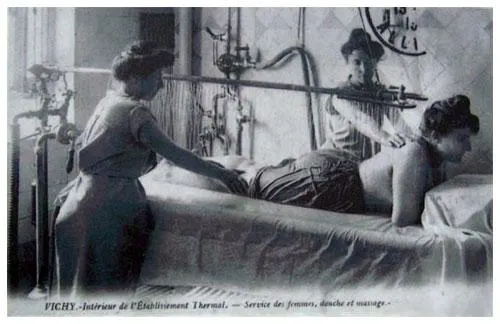HISTORY AND EVOLUTION OF HYDROTHERAPY

Water therapy has been popular for thousands of years. Many ancient civilizations used baths, both natural and man-made for therapeutic and relaxation purposes. History records the ancient Egyptians, Arabians and Mohammedans used baths for curative purposes. Medicinal men in china were using and prescribing water therapy thousands of years before Christ. One of the world’s first and most respected physicians, Hippocrates, studied the influence of heat and cold on organisms and pulse. Homer made mention of the use of baths in the 8th century B.C. The Spartans built the first grand bathhouse in 334 B.C. It could accommodate 3,000 people at once and had a hot air room, an exercise court, hot water baths, cold water baths and a swimming pool so large, the walls were 150 feet high.
The First Bathtub
The first bathtub was found on the Isle of Crete in 1700 B.C. Roman legions found mineral springs helpful for the relief of battle fatigue, for relaxation, to promote hygiene and as a therapy for rheumatism, gout, orgies and even riot control. They built luxurious temples near mineral springs. They also carried portable copper tubs with them as they explored the continent. When Rome’s Tiber River became too polluted for public bathing due to urban expansion, an alternative needed to be found. Thus bathhouses evolved for the wealthy Romans and eventually public bathhouses for the not so wealthy. It has been estimated that Rome’s water use, which was brought in by huge aqueducts, totaled over 2 million gallons per day which is approximately the same amount that modern Romans use today.
Water Therapy in Early Cultures
These early cultures greatly benefitted from water therapies. They didn’t have the scientific research or data that we have today to document why and how water therapy works. Instead they credited the gods for endowing their water with miracle cures. The Greeks worshipped the sea god Poseidon, the Romans worshipped Neptunus (a god of springs) and the Babylonians worshipped Ea, the goddess of sweet waters under the earth. Little did they know it was actually a combination of heat, cold and minerals that made the water work wonders.
Most cultures had tales of miraculous mineral springs which endowed the drinker with youth, health or strength. One such myth surrounds a leper in Bath, England. Bladud was a swine herder whose leprosy was reputedly cured when he lay in his swine’s wallow. Well, the wallow turned out to be the site of Bath’s sulphurous hot springs (and sulphurous water is indeed used in treatments of skin diseases). His pigs had gorgeous skin too, by the way.
Though water therapy became quite in vogue, it didn’t last. The fall of the first forms of water therapy came with the fall of the Roman Empire. The baths became a place of vice and infection and were consequently banned by the early Christians. By 500 A.D. public baths had disappeared from Rome. There was even a time when some cultures preferred the human body “au natural” and the longer between baths the better. Napoleon is reputed to have sent a letter to Josephine saying “I’ll be home in three weeks – don’t bathe”.
The colonial American Puritans believed that bathing promoted promiscuity, therefore bathing wasn’t an accepted practice until the 18th century. It was actually a felony to take a bath in Philadelphia and in Virginia.
The First Spa
Though the first spa, as we know spas today, opened in Spa, Belgium in the year 1326, the use of mineral waters within legitimate, therapeutic establishments finally became more widespread and accepted during the 16th and 17th centuries when hydrotherapy was scientifically understood. An Austrian named Victor Preistnitz, was one of our premier water therapists. He discovered the curative effects of cold water on broken bones; his own broken bones. Preistnitz was a farmer who mangled his hand one day while working in the fields. Someone told him to put cold water packs on his hands. He did so and quickly gained their use. Shortly after, and incident with a runaway wagon caught him unaware and supposedly left him crippled. Though he was certainly having some bad luck, farmer Preistnitz remembered how the cold packs had worked on his hands and he made the same application to his body. Lo and behold, he recuperated quickly ! He began experimenting and practicing various forms of hydrotherapy and spa medicine such as diet and exercise on peasants in Austria. He also documented his findings.
In 1821 a frail and sickly lad named Sebastian Kneipp learned of Preistnitz and his water therapies. Kneipp wanted to become a priest but his studies were constantly being interrupted by illness. He felt he had little to lose by trying some of Preistnitz methods. So, in the middle of the Bavarian winter he would rouse himself every morning and take a plunge in the icy river. It didn’t take long for Kneipp to become well and remain vigorously healthy. He formed an entire system of healing referred to as Kneipp therapy that is still in use today, especially in Europe. You can try a little Kneipp therapy at home or in your spa. Just run cold water in your bathtub (at least ankle deep) and tread water for a few minutes every day. This little trick can keep you free from colds, decongest your head, warm your feet and just perk you up. Try it every day and, like exercise you’ll feel a little “off” if you miss your Kneipp therapy.
Though a lot has happened in Europe, the United States was not without its watering holes and cures. The American Indians were the first to recognize and utilize hydrotherapies. The Cheyenne would always have a morning swim in the local river and, if a natural vapor cave existed, they would use it too. Indian encampments were often established around thermal springs which were used for spiritual and medicinal purposes. Juan Pone de Leon came to Florida in 1513 in search of the so-called Fountain of Youth”. Rumor had it that local Indians visited the mineral springs and were cured and rejuvenated from ailments, the elements, fatigue and aging. Settlers in New England were making pilgrimages to what is believed to be one of Americas’ first spas, Stafford Springs, Connecticut in the late 1600’s. By the mid 1800’s water cures were being practiced all over the United States and grand resorts and hotels were established around curative watering holes by the dozens. Not only were Americans visiting watering holes such as Spa City in Arkansas, Glenwood springs in Colorado, Old Faithful in Yellowstone, White Sulphur Springs in West Virginia but water bottlers were also popular, making health claims and supplying local and municipal markets where people were drinking lots of bottled mineral waters.
Hydrotherapy in the United States
But hydrotherapy in the United States was not destined to last. By 1870 water cures were being prevented in New York City by medical law. In 1914 the Federal Trade Commission put an end to water distributors in Philadelphia who advertised their water as a cure-all. In 1956 the Food and Drug Administration challenged the Mountain Valley water bottler of Hot springs, Arkansas regarding their health claims. Mountain Valley fought back and actually won a grandfather clause allowing them to continue to advertise its mineral water as having therapeutic value. By the 1950’s the public was not drinking much mineral water nor were they visiting mineral springs or health sanatoriums in any great numbers. There was new medicine available.
We were all trying a lot of new things and life was moving into the fast lane. Quick fixes were more popular than old therapies. The American Medical Association was supporting the use of drug therapy and the public was quick to respond to new, fast and effective treatments for their aches and pains. Our health and well-being remains however, very dependant and responsive to natural age old remedies such as hydrotherapy. While we are grateful for all of our medical advances and don’t want to turn back the clock on modern medicine, when you consider that six out of every ten Americans seek some form of natural therapy then you know you’re in the right business.
WaterWerks © 2023 All rights reserved.



